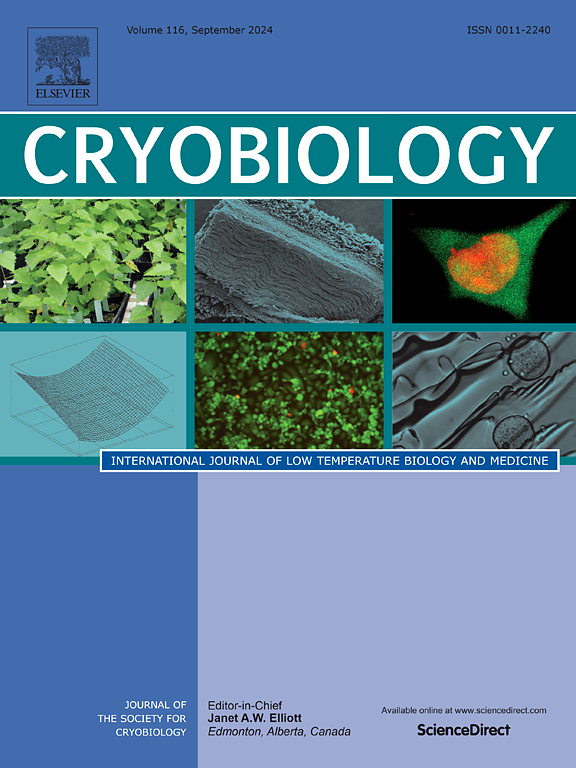Evaluation of post-transfer fertility of vitrified goat morulae and blastocysts using an innovative protocol in micropipette tips
IF 2.1
3区 生物学
Q2 BIOLOGY
引用次数: 0
Abstract
In 2022, we developed an innovative protocol consisting of three vitrification solutions with the addition of sucrose to vitrify goat embryos in micropipette tips (S-VitriTip) and obtained promising in vitro results. However, to date, this protocol has not been tested in vivo in recipient females. The study aimed to evaluate the embryo survival and post-transfer fertility of goat morulae and blastocysts vitrified by the S-VitriTip protocol. Embryo recovery from donor goats (n = 23) was carried out on Days 8 and 9 after sponge removal. Immediately after recovery, morulae and blastocysts were vitrified using the S-VitriTip protocol. Briefly, all embryos were exposed to three different increasing solutions of cryoprotectants (glycerol, ethylene glycol, sucrose), loaded into micropipette tips and stored in liquid nitrogen. After warming, embryos were transferred in pairs into recipient goats (n = 47); morulae and blastocysts were transferred on the same day they were recovered, either Day 8 or Day 9 after sponge removal. On day 25 after embryo transfer, ultrasound diagnosis was performed. No significant differences were observed on embryo survival nor on post-transfer fertility according to embryo stage or day of embryo recovery (42 and 50 %, respectively; P > 0.05). Embryo survival and post-transfer fertility of vitrified morulae of 30 % and 40 % were obtained, highlighting our study as one of the first to report efficient reproductive rates through the in vivo transfer of cryopreserved goat morulae, thus demonstrating the effectiveness of this innovative vitrification protocol.
利用微移液管尖端的创新方案评估玻璃化山羊桑葚胚和囊胚移植后的生育能力。
2022年,我们开发了一种创新的方案,包括三种玻璃化溶液,添加蔗糖,在微移液管尖端(S-VitriTip)中玻璃化山羊胚胎,并获得了有希望的体外结果。然而,迄今为止,该方案尚未在雌性受体体内进行过试验。本研究旨在评价采用S-VitriTip法玻璃化的山羊桑葚胚和囊胚的胚胎存活率和移植后的生育能力。供体山羊(n = 23)在海绵去除后第8天和第9天进行胚胎恢复。恢复后立即使用S-VitriTip方法将桑葚胚和囊胚玻璃化。简单地说,所有胚胎都暴露在三种不同的冷冻保护剂(甘油,乙二醇,蔗糖)的增加溶液中,装入微移管尖端并储存在液氮中。加热后,将胚胎成对移植到受体山羊体内(n = 47);桑葚胚和囊胚在取出海绵后的第8天或第9天当天移植。胚胎移植后第25天进行超声诊断。胚胎期和胚胎恢复天数对胚胎存活率和移植后生育能力均无显著影响(分别为42%和50%);p > 0.05)。玻璃化桑葚胚的胚胎存活率和移植后的受精率分别为30%和40%,这表明我们的研究是第一个通过冷冻保存的山羊桑葚胚在体内移植获得高效繁殖率的研究之一,从而证明了这种创新的玻璃化方案的有效性。
本文章由计算机程序翻译,如有差异,请以英文原文为准。
求助全文
约1分钟内获得全文
求助全文
来源期刊

Cryobiology
生物-生理学
CiteScore
5.40
自引率
7.40%
发文量
71
审稿时长
56 days
期刊介绍:
Cryobiology: International Journal of Low Temperature Biology and Medicine publishes research articles on all aspects of low temperature biology and medicine.
Research Areas include:
• Cryoprotective additives and their pharmacological actions
• Cryosurgery
• Freeze-drying
• Freezing
• Frost hardiness in plants
• Hibernation
• Hypothermia
• Medical applications of reduced temperature
• Perfusion of organs
• All pertinent methodologies
Cryobiology is the official journal of the Society for Cryobiology.
 求助内容:
求助内容: 应助结果提醒方式:
应助结果提醒方式:


